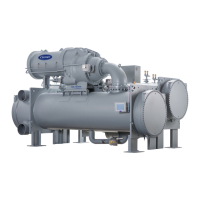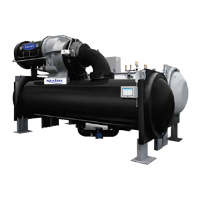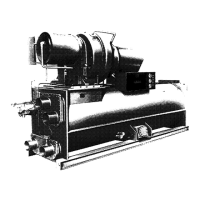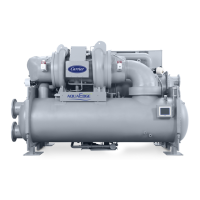Modify Minimum and Maximum Load Points (DT1/P1;
D T2/P2) If Necessary — These pairs of chiller load points,
located on the OPTIONS screen, determine when to limit
guide vane travel or open the hot gas bypass valve when
surge prevention is needed. These points should be set based
on individual chiller operating conditions.
If after configuring a value for these points, surge preven-
tion is operating too soon or too late for conditions, these
parameters should be changed by the operator.
An example of such a configuration is shown below.
Refrigerant: HCFC-134a
Estimated Minimum Load Conditions:
44 F (6.7 C) LCW
45.5 F (7.5 C) ECW
43 F (6.1 C) Suction Temperature
70 F (21.1 C) Condensing Temperature
Estimated Maximum Load Conditions:
44 F (6.7 C) LCW
54 F (12.2 C) ECW
42 F (5.6 C) Suction Temperature
98 F (36.7 C) Condensing Temperature
Calculate Maximum Load — To calculate the maximum load
points, use the design load condition data. If the chiller
full load cooler temperature difference is more than 15 F
(8.3 C), estimate the refrigerant suction and condensing tem-
peratures at this difference. Use the proper saturated pres-
sure and temperature for the particular refrigerant used.
Suction Temperature:
42 F (5.6 C) = 37 psig (255 kPa) saturated
refrigerant pressure (HFC-134a)
Condensing Temperature:
98 F (36.7 C) = 120 psig (1827 kPa) saturated
refrigerant pressure (HFC-134a)
Maximum Load DT2:
54 – 44 = 10° F (12.2 – 6.7 = 5.5° C)
Maximum Load DP2:
120 – 37 = 83 psid (827 – 255 = 572 kPad)
To avoid unnecessary surge prevention, add about 10 psid
(70 kPad) to DP2 from these conditions:
DT2 = 10° F (5.5° C)
DP2 = 93 psid (642 kPad)
Calculate Minimum Load — To calculate the minimum load
conditions, estimate the temperature difference the cooler will
have at 10% load, then estimate what the suction and con-
densing temperatures will be at this point. Use the proper
saturated pressure and temperature for the particular refrig-
erant used.
Suction Temperature:
43 F (6.1 C) = 38 psig (262 kPa) saturated
refrigerant pressure (HFC-134a)
Condensing Temperature:
70 F (21.1 C) = 71 psig (490 kPa) saturated
refrigerant pressure (HFC-134a)
Minimum Load DT1 (at 20% Load): 2 F (1.1 C)
Minimum Load DP1:
71 – 38 = 33 psid (490 – 262 = 228 kPad)
Again, to avoid unnecessary surge prevention, add 20 psid
(140 kPad) at DP1 from these conditions:
DT1=2F(1.1 C)
DP1 = 53 psid (368 kPad)
If surge prevention occurs too soon or too late:
LOAD
SURGE PREVENTION
OCCURS TOO SOON
SURGE PREVENTION
OCCURS TOO LATE
At low
loads
(,50%)
Increase P1 by 10 psid
(70 kPad)
Decrease P1 by 10 psid
(70 kPad)
At high
loads
(.50%)
Increase P2 by 10 psid
(70 kPad)
Decrease P2 by 10 psid
(70 kPad)
The differential pressure (DP) and temperature (DT) can
be monitored during chiller operation by viewing ACTIVE
DELTA P and ACTIVE DELTA T (HEAT_EX screen). Com-
paring SURGE/AGBP DELTA T to active DETLA T will de-
termine when the SURGE PREVENTION function will oc-
cur. The smaller the difference between the SURGE/AGBP
DELTA T and the ACTIVE DELTA T values, the closer to
surge prevention.
CONFIGURE DIFFUSER CONTROL IF NECESSARY —
If the compressor is equipped with a variable diffuser,
(5 size compressor) access the SETUP2 screen. Scroll to DIF-
FUSER CONTROL and press the ENABLE
softkey. Enter
the correct diffuser and guide vane values (GUIDE VANE
25% LOAD PT, GUIDE VANE 50 % LOAD PT, GUIDE VANE
75% LOAD PT, DIFFUSER 25% LOAD PT, DIFFUSER 50%
LOAD PT, DIFFUSER 75% LOAD PT). Default values are
located on the label inside the control panel. See Fig. 10. To
obtain proper settings for diffuser control, contact a Carrier
Engineering representative.
Compressors with variable diffuser control have actuators
tested and stamped with the milliamp (mA) value that
results in 100% actuator rotation. This valve is configured
on the SETUP2 screen. It is labeled DIFFUSER FULL
SPAN mA.
MODIFY EQUIPMENT CONFIGURATION IF NECES-
SARY — The EQUIPMENT SERVICE table has screens to
select, view, or modify parameters. Carrier’s certified draw-
ings have the configuration values required for the jobsite.
Modify these values only if requested.
SERVICE Screen Modifications — Change the values on these
screens according to specific job data. See the certified draw-
ings for the correct values. Modifications can include:
• chilled water reset
• entering chilled water control (Enable/Disable)
• 4 to 20 mA demand limit
• auto restart option (Enable/Disable)
• remote contact option (Enable/Disable)
Owner-Modified CCN Tables— The following EQUIP-
MENT CONFIGURATION screens are described for refer-
ence only.
OCCDEFCS — The OCCDEFCS screen contains the Local
and CCN time schedules, which can be modified here or on
the SCHEDULE screen as described previously.
HOLIDAYS — From the HOLIDAYS screen, the days of the
year that holidays are in effect can be configured. See the
holiday paragraphs in the Controls section for more
details.
BRODEF — The BRODEF screen defines the start and end
of daylight savings time. Enter the dates for the start and end
of daylight savings if required for your location. BRODEF
also activates the Broadcast function which enables the holi-
day periods that are defined on the CVC to take effect.
Other Tables — The CONSUME, and RUNTIME screens
contain parameters used with a CCN system. See the appli-
cable CCN manual for more information on these screens.
These tables can only be defined from a CCN Building
Supervisor.
55

